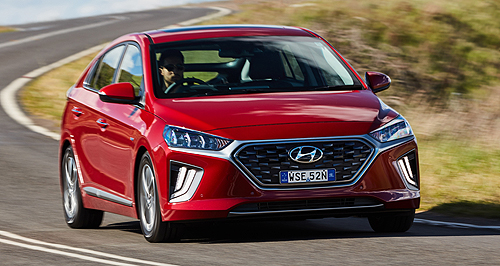Make / Model Search
News - Hyundai - IONIQImproved Hyundai Ioniq Electric to increase salesBetter range should help Hyundai Ioniq Electric outsell plug-in, hybrid siblings8 Nov 2019 HYUNDAI is confident that the battery-electric Ioniq Electric will increase its dominance over its petrol-electric Plug-in and Hybrid siblings despite costing $3500 more in facelifted form.
On sale this week from $34,790 plus on-road costs for the Hybrid Elite, all refreshed Ioniq variants usher in revised front and rear styling, a redesigned dashboard, extra standard equipment, improved driver-assist safety technology and an upgraded suspension tune, helping justify an $800 and $1000 price hike on the Hybrid and Plug-In (from $41,990) respectively.
However, now from $48,490, the facelifted Electric goes further with a larger battery (from 28kWh to 38.3kWh) and a more powerful motor (from 88kW to 100kW), extending range, from 204km to 311km in the World harmonized Light-duty vehicles Test Procedure (WLTP) as well as performance.
Better thermal management and expected durability for the lithium-ion polymer battery are further upshots, since it also switches from air-cooling to liquid-cooling for the facelift.
Hyundai Motor Company Australia (HMCA) product planning manager Jonathan Lam is confident the Electric will build on the success of the pre-facelift Ioniq, given such clear consumer benefits that the latest iteration brings.
“In theory, it should,” he told GoAuto at the launch of the facelifted Ioniq range in Sydney last week. “As a car that’s got a lot longer range that’s more viable for long-distance travel and more practical for the everyday person, it could represent a higher mix of sales, but exactly how much, we don’t really know. We’ll need to see how the market reacts to it.
“(But) barring any unexpected change in the market, we expect the current range to retain the mix we’ve sold in the previous version.”
Of the circa-540 sales from launch late last year to the end of September, 42 per cent were Electric (225 units), 37 per cent Hybrid (nearly 200 units) and 22 per cent Plug-in (about 115 units).
Mr Lam agreed that Hyundai is buoyed in Australia by the relatively high demand for the redesigned all-electric Nissan Leaf, which is at 286 units (to the end of September) in spite of sales only officially commencing in July. In contrast, all three Ioniq versions totalled 346 registrations for the first nine months of this year.
“Absolutely,” he said. “Overall, we’ve seen that the Australian market has been a lot more receptive within the last couple of years. With us introducing our EVs, Nissan introducing their EV and even Tesla introducing the Model 3, all of that has helped drive more widespread acceptance of this sort of market. For everybody, it’s good.”
The Leaf, by the way, is $1500 more expensive than the Electric Elite, from $49,990 (before ORC), but $2500 cheaper than the Electric Premium flagship.
HMCA senior manager of future mobility and government relations Scott Nargar agrees that consumers would rather pay the small price premium for all of the advances that the Ioniq Electric has made in its latest guise.
“We do have a lot of technology going into the vehicle… it’s gone from a 28kWh to 38.3kWh and it’s picked up a liquid-cooled battery as well, bolstering the battery’s longevity… so it’s a range of technologies that have gone in that vehicle that’s upped that price,” he said.
“Such technology does not come for free; the kWh price of batteries is still expensive, the raw materials are still expensive to buy in the global market… so really the price increase reflects the cost of those batteries.”
Mr Lam said that while HMCA is not specifically relying on another oil price spike in the near future to help boost EV sales, he did say that diesel’s rollercoaster ride over the last decade might also apply to EVs in the future.
“We factor in overall trends of fuel prices when we think about product planning,” he said. “Maybe not explicitly down to what price will the market tick over. We saw a lot of that with diesel (in the mid-to-late 2000s), when petrol prices started increasing and at that time diesel uptake increased dramatically. But as soon petrol prices came back down, the trend to diesels moved backwards, too. So, it’s something we do take into consideration.”  Read more |
Click to shareHyundai articlesResearch Hyundai Motor industry news |












Facebook Twitter Instagram